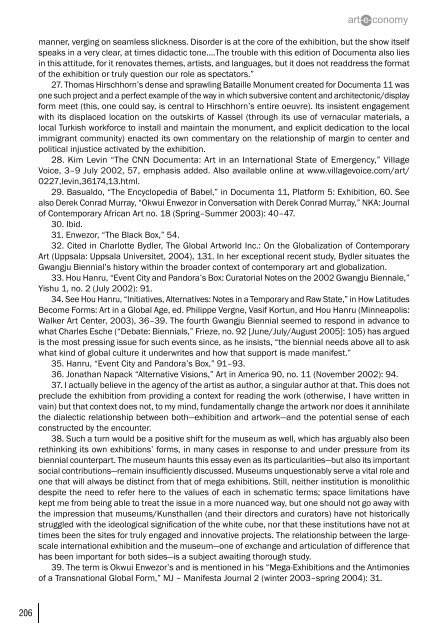art-e-conomy _ reader - marko stamenkovic
art-e-conomy _ reader - marko stamenkovic
art-e-conomy _ reader - marko stamenkovic
You also want an ePaper? Increase the reach of your titles
YUMPU automatically turns print PDFs into web optimized ePapers that Google loves.
206<br />
manner, verging on seamless slickness. Disorder is at the core of the exhibition, but the show itself<br />
speaks in a very clear, at times didactic tone….The trouble with this edition of Documenta also lies<br />
in this attitude, for it renovates themes, <strong>art</strong>ists, and languages, but it does not readdress the format<br />
of the exhibition or truly question our role as spectators.”<br />
27. Thomas Hirschhorn’s dense and sprawling Bataille Monument created for Documenta 11 was<br />
one such project and a perfect example of the way in which subversive content and architectonic/display<br />
form meet (this, one could say, is central to Hirschhorn’s entire oeuvre). Its insistent engagement<br />
with its displaced location on the outskirts of Kassel (through its use of vernacular materials, a<br />
local Turkish workforce to install and maintain the monument, and explicit dedication to the local<br />
immigrant community) enacted its own commentary on the relationship of margin to center and<br />
political injustice activated by the exhibition.<br />
28. Kim Levin “The CNN Documenta: Art in an International State of Emergency,” Village<br />
Voice, 3–9 July 2002, 57, emphasis added. Also available online at www.villagevoice.com/<strong>art</strong>/<br />
0227,levin,36174,13.html.<br />
29. Basualdo, “The Encyclopedia of Babel,” in Documenta 11, Platform 5: Exhibition, 60. See<br />
also Derek Conrad Murray, “Okwui Enwezor in Conversation with Derek Conrad Murray,” NKA: Journal<br />
of Contemporary African Art no. 18 (Spring–Summer 2003): 40–47.<br />
30. Ibid.<br />
31. Enwezor, “The Black Box,” 54.<br />
32. Cited in Charlotte Bydler, The Global Artworld Inc.: On the Globalization of Contemporary<br />
Art (Uppsala: Uppsala Universitet, 2004), 131. In her exceptional recent study, Bydler situates the<br />
Gwangju Biennial’s history within the broader context of contemporary <strong>art</strong> and globalization.<br />
33. Hou Hanru, “Event City and Pandora’s Box: Curatorial Notes on the 2002 Gwangju Biennale,”<br />
Yishu 1, no. 2 (July 2002): 91.<br />
34. See Hou Hanru, “Initiatives, Alternatives: Notes in a Temporary and Raw State,” in How Latitudes<br />
Become Forms: Art in a Global Age, ed. Philippe Vergne, Vasif Kortun, and Hou Hanru (Minneapolis:<br />
Walker Art Center, 2003), 36–39. The fourth Gwangju Biennial seemed to respond in advance to<br />
what Charles Esche (“Debate: Biennials,” Frieze, no. 92 [June/July/August 2005]: 105) has argued<br />
is the most pressing issue for such events since, as he insists, “the biennial needs above all to ask<br />
what kind of global culture it underwrites and how that support is made manifest.”<br />
35. Hanru, “Event City and Pandora’s Box,” 91–93.<br />
36. Jonathan Napack “Alternative Visions,” Art in America 90, no. 11 (November 2002): 94.<br />
37. I actually believe in the agency of the <strong>art</strong>ist as author, a singular author at that. This does not<br />
preclude the exhibition from providing a context for reading the work (otherwise, I have written in<br />
vain) but that context does not, to my mind, fundamentally change the <strong>art</strong>work nor does it annihilate<br />
the dialectic relationship between both—exhibition and <strong>art</strong>work—and the potential sense of each<br />
constructed by the encounter.<br />
38. Such a turn would be a positive shift for the museum as well, which has arguably also been<br />
rethinking its own exhibitions’ forms, in many cases in response to and under pressure from its<br />
biennial counterp<strong>art</strong>. The museum haunts this essay even as its p<strong>art</strong>icularities—but also its important<br />
social contributions—remain insufficiently discussed. Museums unquestionably serve a vital role and<br />
one that will always be distinct from that of mega exhibitions. Still, neither institution is monolithic<br />
despite the need to refer here to the values of each in schematic terms; space limitations have<br />
kept me from being able to treat the issue in a more nuanced way, but one should not go away with<br />
the impression that museums/Kunsthallen (and their directors and curators) have not historically<br />
struggled with the ideological signification of the white cube, nor that these institutions have not at<br />
times been the sites for truly engaged and innovative projects. The relationship between the largescale<br />
international exhibition and the museum—one of exchange and <strong>art</strong>iculation of difference that<br />
has been important for both sides—is a subject awaiting thorough study.<br />
39. The term is Okwui Enwezor’s and is mentioned in his “Mega-Exhibitions and the Antimonies<br />
of a Transnational Global Form,” MJ – Manifesta Journal 2 (winter 2003–spring 2004): 31.


